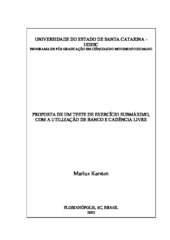Proposta de um teste de exercício submáximo, com a utilização de banco e cadência livre
Resumo
This study aims to evaluate the functional capacity of old people or chronic degenerative disease (CDD) patients using sub-maximum tests. The sub-maximum tests, which use a step as ergometer, usually have two features that makes difficult its usage by the considered subjects (old people or CDD patients): the cadence is constant and the step height is not proportional to their physical condition. Thus, the intention is to develop and validates a test to functional capacity evaluation of 60 to 69 years old subjects, using a 15 centimeters step height as ergometer and self-paced. The self-paced step test (SPST) was compared to six-minute walk text (6MWT) in a sample (12 male; 35 female) from Itajaiaçu River region population. Reliability in both tests was evaluated; the SPST required time for cardiovascular, breath, and comfort alterations were compared to 6MWT alterations and it was established a performance correlation (functional capacity) of the subjects in both tests. Each test was performed two times for the subjects (test/re-test) and the second time data were used to comparison between tests. The cardiovascular parameters (heart rate HR and arterial blood pressure BP), the breath parameters (arterial oxygen saturation SpO2), and the comfort parameters (pain perception in the inferior members DOR and effort perception SSE), were measured and used in the statistical analysis that includes: F test, Student T test, Wilcoxon Test, all of them with significance level p ≤ 0.05; the Pearson s correlation was used in reliability and validation evaluation. The most important results were: between the two SPST and 6MWT measures were found a good correlation and no statistical difference was found in significance level p ≤ 0.05; comparing the second measures of the tests no statistical difference was found between BP and SpO2 averages. The HR had a different behavior between tests, with p=0.0436 in the 5th minute and p=0.0121 in 6th minute. DOR have show p=0.0018 in 4th minute and p=0.0007 in 6th, and the SSE had p=0.1638 in 4th minute and p=0.0003 in the 6th minute. The r values (correlation coefficient) were equal or bigger than 0.7 for HR, BP, SpO2 (5th and 6th minute) and for functional capacity (4th to 6th min). The results show that the evaluation tests are reliable and that SPST validation was found for the studied subjects. Besides, it is possible to conclude that in the 4th min test the SPST reached a similar effect to 6MWT.
